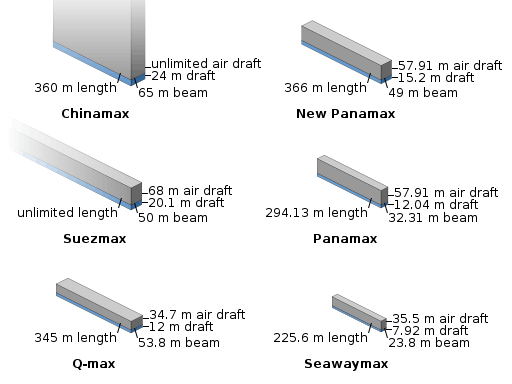Q-Max
| | |
| Class overview | |
|---|---|
| Name: | Q-Max |
| Builders: | |
| Built: | c. 2007–2010 |
| In service: | Mozah,[1] Al Mayeda,[2] Mekaines,[3] Al Mafyar,[3] Umm Slal, Bu Samra,[4][5] Al-Ghuwairiya,[4] Lijmiliya,[6] Al Samriya, Al Dafna, Shagra, Zarga, Aamira, Rasheeda[7] |
| Planned: | 14 |
| Completed: | 14 |
| Cancelled: | - |
| Active: | 14 |
| Lost: | - |
| Retired: | - |
| Preserved: | - |
| General characteristics | |
| Type: | LNG carrier |
| Length: | 345 m (1,132 ft) |
| Beam: | 53.8 m (177 ft) |
| Height: | 34.7 m (114 ft) |
| Draft: | 12 m (39 ft) |
| Installed power: | 21,770 kW at 91 rpm, per engine[8] |
| Propulsion: | 2 × MAN B&W 7S70ME-C two-stroke low speed diesel, electronically controlled[8] |
| Capacity: | 266,000 m3 (9,400,000 cu ft) |
Q-Max is a type of ship, specifically a membrane type liquefied natural gas carrier. In the name Q-Max, "Q" stands for Qatar and "Max" for the maximum size of ship able to dock at the LNG terminals in Qatar. Ships of this type are the largest LNG carriers in the world.[1][9]
Technical description

A ship of Q-Max size is 345 metres (1,132 ft) long and measures 53.8 metres (177 ft) wide and 34.7 metres (114 ft) high, with a draft of approximately 12 metres (39 ft).[9][10]
It has an LNG capacity of 266,000 cubic metres (9,400,000 cu ft), equal to 161,994,000 cubic metres (5.7208×109 cu ft) of natural gas. It is propelled by two slow speed diesel engines, which are claimed to be more efficient and environmentally friendly than traditional steam turbines.[11]
Q-Max vessels are equipped with an on-board re-liquefaction system to handle the boil-off gas, liquefy it and return the LNG to the cargo tanks.[12] The on-board re-liquefaction system allows a reduction of LNG losses, which produces economic and environmental benefits.
Overall, it is estimated that Q-Max carriers have about 40% lower energy requirements and carbon emissions than conventional LNG carriers.[13][14] The quoted estimates do however ignore the additional fuel used to re-liquify boil off gas rather than burn the gas for fuel. The ships can be converted to use the boil-off gas but as of February 2013 none have yet been converted.
Contractors
Q-Max LNG carriers were ordered in 2005.[9] They are to be built by Samsung Heavy Industries and Daewoo Shipbuilding & Marine Engineering.[9][13] The installed Boil Off Gas re-liquefaction system (Ecorel) is developed and delivered by Cryostar, and approved and certified by Lloyds Register.[15]
Ships
The first Q-Max LNG carrier was floated out of dry-dock in November 2007.[14] The naming ceremony was held on 11 July 2008 at Samsung Heavy Industries' shipyard on Geoje Island, South Korea.[1] Known before its naming ceremony as Hull 1675, the ship was named Mozah by Her Highness Sheikha Mozah Nasser al-Misnad.[16] Mozah was delivered on 29 September 2008.[16][17] It is classed by Lloyd's Register.[1] The first trip by a Q-Max tanker was completed by Mozah itself on 11 January 2009, when the tanker delivered 266,000 cubic metres of LNG to the Port of Bilbao BBG Terminal. Days before, the vessel had transited the Suez Canal for the first time.[18]
Q-Max LNG carriers are operated by the STASCo (Shell International Trading and Shipping Company, London part of Shell International. They are owned by Qatar Gas Transport Company (Nakilat) and they are chartered to Qatar's LNG producers Qatargas and RasGas.[1] In total, contracts have been signed for the construction of 14 Q-Max vessels.[19]
See also
References
- 1 2 3 4 5 "Qatargas, Nakilat Name World's Largest LNG Vessel". Lloyd's Register. Downstream Today. 2008-07-11. Retrieved 2008-08-02.
- ↑ "Nakilat gets Q-Max LNG carrier from Samsung Heavy". yourshipbuildingnews.com. 2009-02-20. Retrieved 2009-05-07.
- 1 2 "Nakilat and Qatargas name ten of the world's largest LNG carriers". ameinfo.com. 2009-02-09. Retrieved 2009-05-07.
- 1 2 "Naqilat Takes Delivery Of Two More Q-Max LNG Carriers". Zawya. 2008-10-06. Retrieved 2009-05-07.
- ↑ "Qatargas And Nakilat Name Five Q-Max LNG Carriers". Business Life. 2008-08-26. Retrieved 2012-01-02.
- ↑ "Lijmiliya". South Hook LNG Ship Noise Community Group. Retrieved 2011-07-30.
- ↑ "Nakilat, Qatargas Name Final 4 LNG Q-Max Carriers". Gulf Oil and Gas. 2009-09-11. Retrieved 2012-01-02.
- 1 2 "MAN B&W power for Q-max LNG ships". allbusiness.com. 2006-05-01. Retrieved 2009-05-07.
- 1 2 3 4 Cho Jae-eun (2008-07-09). "Korea launches new tankers. Qatar-bound Mozah is the biggest LNG carrier ever built". Korea JoongAng Daily. Retrieved 2008-08-02.
- ↑ Curt, Bob (2004-03-29). Marine Transportation of LNG (PDF). Intertanko Conference. Maritime Administration. Retrieved 2011-07-30.
- ↑ "Qatargas' Q-Flex arrives in the United States". AME Info. 2008-06-24. Retrieved 2008-08-02.
- ↑ Richardsen, Per Wiggo (2006-12-04). "First reliquefaction plant installed on board an LNG carrier". DNV UK. Retrieved 2008-08-02.
- 1 2 Pratap John (2008-02-24). "South Korea building 54 ships for Qatar". Gulf Times. Retrieved 2008-08-02.
- 1 2 "First LNG 'Mega-ship' Floats Out of Dry-dock". Downstream Today. 2007-11-19. Retrieved 2008-08-02.
- ↑ "EcoRel, how it works" (PDF). The Cryostar Magazine. Cryostar (10). Autumn 2007. Retrieved 2009-02-06.
- 1 2 "Qatar makes history with largest LNG ship". Gulf Times. 2008-07-12. Retrieved 2008-08-02.
- ↑ "LNG carrier "Mozah" delivered to Qatargas and Nakilat" (Press release). Qatargas. 2008-09-29. Retrieved 2008-11-28.
- ↑ "Bilbao received the first LNG cargo carried by a Q-Max, the largest gas carrier in the world" (Press release). STREAM. 2009-01-14. Retrieved 2009-08-13.
- ↑ "Four Q-Flex LNG carriers to be named this week". The Peninsula. 2007-11-14. Retrieved 2008-08-02.